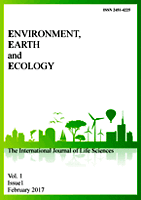| 1. |
Alavalapati J, Nair PKR, Barkin D (2001) Socioeconomic and institutional perspectives of agroforestry. In World Forests, markets and policies. Springer Netherlands, Pages 71-83.
|
| 2. |
Almazbek Orozumbekov (2010) Associate Professor, Centre of Innovation Technology in Agriculture of Faculty of Innovation Technology, Kyrgyz National Agrarian University, Bishkek, Kyrgyzstan.
|
| 3. |
Aussie (2007) N.P. Problems of Forestry; Forestry Production: Moscow, Russia, 1986. (In Russian).
|
| 4. |
Avery and Burkhart (2006) Forest Measurements. Fifth Edition, McGraw Hill, New York. 2002.
|
| 5. |
Bertomeu, World Agroforestry Centre(ICRAF),Financial Evaluation of Smallholder Timber-based Agroforestry Systems in Claveria, Northern Mindanao, the Philippines, Small-scale Forest Economics, Management and Policy, College of Forestry and Natural Resources Administration Building 4031 College, Laguna, the Philippines, Vol: 5(1): 57-82, 2006 57. Available on: http://www.worldagroforestry.o... Assessed on: 29/05/2017.
|
| 6. |
Boardman AE, Greenberg DH, Vining AR, Weimer DL (2006) Cost-benefit analysis: concepts and practice (Vol. 3). Upper Saddle River, NJ: Prentice Hall.
|
| 7. |
Holding A and Roshetko JM (2002) FAO Corporate Document Repository, Farm-level timber production: orienting farmers towards the market. Available on: http://www.fao.org/docrep/005/.... Assessed on 05/03/2017.
|
| 8. |
Central Intelligence Agency (2014) CIA World Factbook. Percentage of population below the poverety line by country.
|
| 9. |
Wallin C (2008) Growing Walnut Trees for Profit, Profitable Plant Digest.
|
| 10. |
Djanibekov UA (2015) Coevolutionary perspective on the adoption of sustainable land use practices: The case of the Amu Darya River lowlands, Uzbekistan. In Applying Evolutionary Governance Theory; Beunen, R., van Assche, K., Duineveld, M., Eds.; Springer: Berlin/Heidelberg, Germany. 233–245.
|
| 11. |
Dzhakypbekova K (2014) Potential of Agroforestry Systems in Kyrgyzstan. Master’s Thesis, Kyrgyz National Agrarian University, Bishkek, Kyrgyzstan.
|
| 12. |
FAO Corporate Document Repositort (2011) Estimating biomass and biomass change in tropical forests, Appendix 1-List of wood densities for tree species from tropical America, Africa and Asia. http://www.fao.org/docrep/w409....
|
| 13. |
Folliot PF, Irving FD, Duncan DP (1960) The growth potential of black walnut in south-eastern Minnesota, Minnesota Forestry Notes No.97, school of forestry, university of Minnesota, st. paul Minnesota Published as Sci.Jour.Ser. Paper.
|
| 14. |
Food and Agriculture Organization of the United Nations (2010) Forest Cover, Forest types, Breakdown of forest types, Change in Forest Cover, Primary forests, Forest designation, Disturbances affecting forest land, Value of forests, Production, trade and consumption of forest products.
|
| 15. |
Husch B, Miller CI, Beers TW (1982) Forest Mensuration. Wiley. New York. 402p.
|
| 16. |
ICRAF, World Agroforestry Centre (2017) Transforming lives and landscapes with trees, http://www.worldagroforestry.o....
|
| 17. |
Klara Dzhakybekova (2014) Dr. Horst Weyerhaeuser(UCA/MSRI) Agroforestry practices in Kyrgyzstan. http://www.tropentag.de/2014/a....
|
| 18. |
Minn.Agr.Exp.Sta.https://www.forestry.umn.edu/s....
|
| 19. |
Müller U, Sorg JP (2001) Gestion multifonctionelle des forêts de noyer du sud du Kyrgyzstan: tradition, problèmes actuels, perspectives. Schweiz. Zeitschrift Forstwesen 152(3): 138-144.
|
| 20. |
Nihoul JCJ, Zavialov PO, Micklin PP (2012) Dying and Dead Seas Climatic Versus. Anthropogenic Causes. Springer Science +Business Media. P. 21.
|
| 21. |
Pedley L (2003) A synopsis of Racosperma. C.Mart. (Leguminosae: Mimosoideae). Austrobaileya. 6 (3): 445–496.
|
| 22. |
Profor (2012) Analysis of the Walnut value Chain in the Kyrgyz Republic, Program on Forests, https://www.profor.info/sites/....
|
| 23. |
Rahman SA, De Groot WT, Snelder DJ (2008) Exploring the agroforestry adoption gap: financial and socioeconomics of litchi-based agroforestry by smallholders in Rajshahi (Bangladesh). In Smallholder tree growing for rural development and environmental services (pp. 227-243). Springer Netherlands.
|
| 24. |
Rasul and Thapa (2006) Biodiversity, Biofuels, Agroforestry and Conservation Agriculture, Sustainable Agricultural Reviews, Vol.5, Springer. ISBN 978-90-481-9512-1, DOI 10.1007/978-90-481-9513-8.
|
| 25. |
Semu L, Xiang-wen D, Zhi-hong H, Wen-Hua X, Wen-de Y, Pi-Feng L, Xiao-Lu Z, Chang-Hui P (2015) Development and Evaluation of Models for the Relationship between Tree Height and Diameter at Breast Height for Chinese-Fir Plantations in Subtropical China https://doi.org/10.1371/journa....
|
| 26. |
Semu Hardiwinoto S, Van Andel J (2007) Plant and bird diversity in agro rubber forests in the lowlands of Sumatra, Indonesia. Agroforestry Systems , 70 (3), 217-242.
|
| 27. |
Suman Subedi (2016) Measurement of age-biomass relationship of poplar in agroforestry in Kyrgyzstan, Master Thesis, Ernst Moritz Arndt University Greifswald.
|
| 28. |
The World Bank (2017) Kyrgyz Republic, http://data.worldbank.org/indi....
|
| 29. |
The World Factbook:Kyrgyzstan, United States Central Intelligence Agency.
|
| 30. |
Von Maydell HJ (1983) Forst- und Holzwirtschaft der Sowjetunion: Teil 4: Kasachstan und die mittelasiatischen Sowjetrepubliken Usbekistan, Kirgisien, Tadshikistan, Turkmenien. Mitteilungen der Bundesforschungsanstalt für Forst- und Holzwirtschaft Nr. 140. Hamburg, Bundesforschungsanstalt für Forst- und Holzwirtschaft.
|
| 31. |
Waldwirtschaftsplan Forsteinrichtung, Bundesforschungs- und Ausbildungszentrum für Wald, Naturgefahren und Landschaft Austria (BFW): Waldwirtschaftsplan Forsteinrichtung http://bfw.ac.at/ort1/Vortraeg....
|
| 32. |
Zhou X, Hemstrom MA (2010) Timber volume and aboveground live tree biomass estimations for landscape analyses in the Pacific Northwest.
|








